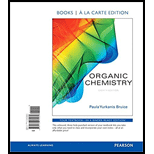
(a)
Interpretation:
The appropriate reagents should be given for each steps in the given reaction.
Concept introduction:
Dehydration reaction:
Removal of water molecule from the reaction of alcohol with strong acid like sulfuric acid is known as dehydration reaction.

The stability of carbocation is given below, Tertiary carbocation is more stable than the secondary and primary.
The alcohols is reaction with acids like hydrochloric acid or hydrobromic, which yield the corresponding carbocation intermediate, this carbocation intermediate undergoes elimination reaction which yields the corresponding
Hydroboration:
Hydroboration is the addition of a hydrogen-boron bond to the Carbon-Carbon, Carbon-Nitrogen, and Carbon-Oxygen double bonds and Carbon-Carbon triple bonds.
When alkene undergoes hydroboration using alkyl borane and hydrogen peroxide followed by hydrolysis which yields the alcohol. The formation of alcohol is depends on the less hindered carbon of the double bond.

In the nucleophilic substitution reaction, the
In
Reactant and nucleophile are present at the rate determination step.
The order of species involving in
Tertiary < Secondary < Primary
Ozonolysis:
Alkene reacts with ozone to gives

Oxidation of alcohol:
Alcohols reacts with hypochlorous (oxidizing agent) in the presence of acetic acid which yields the corresponding aldehyde and
Primary alcohols gives aldehyde, secondary alcohols gives ketone.


(b)
Interpretation:
The appropriate reagents should be given for each steps in the given reaction.
Concept introduction:
Dehydration reaction:
Removal of water molecule from the reaction of alcohol with strong acid like sulfuric acid is known as dehydration reaction.

The stability of carbocation is given below, Tertiary carbocation is more stable than the secondary and primary.
The alcohols is reaction with acids like hydrochloric acid or hydrobromic which yield the corresponding carbocation intermediate, this carbocation intermediate undergoes elimination reaction which yields the corresponding alkene as a product.
Hydroboration:
Hydroboration is the addition of a hydrogen-boron bond to the Carbon-Carbon, Carbon-Nitrogen, and Carbon-Oxygen double bonds and Carbon-Carbon triple bonds.
When alkene undergoes hydroboration using alkyl borane and hydrogen peroxide followed by hydrolysis which yields the alcohol. The formation of alcohol is depends on the less hindered carbon of the double bond.

In the nucleophilic substitution reaction, the rate of reaction depends on reactant as well as nucleophile, which are involved in reaction is called bimolecular nucleophilic substitution reaction.
In
Reactant and nucleophile are present at the rate determination step.
The order of species involving in
Tertiary < Secondary < Primary
Ozonolysis:
Alkene reacts with ozone which cleaves the double bond followed by work up with dimethyl sulfide to forms ketone with aldehyde is known as ozonolysis.

Oxidation of alcohol:
Alcohols reaction with hypochlorous (oxidizing agent) in the presence of acetic acid which yields the corresponding aldehyde and ketones.
Primary alcohols gives aldehyde, secondary alcohols gives ketone.


(c)
Interpretation:
The appropriate reagents should be given for each steps in the given reaction.
Concept introduction:
Dehydration reaction:
Removal of water molecule from the reaction of alcohol with strong acid like sulfuric acid is known as dehydration reaction.

The stability of carbocation is given below, Tertiary carbocation is more stable than the secondary and primary.
The alcohols is reaction with acids like hydrochloric acid or hydrobromic which yield the corresponding carbocation intermediate, this carbocation intermediate undergoes elimination reaction which yields the corresponding alkene as a product.
Hydroboration:
Hydroboration is the addition of a hydrogen-boron bond to the Carbon-Carbon, Carbon-Nitrogen, and Carbon-Oxygen double bonds and Carbon-Carbon triple bonds.
When alkene undergoes hydroboration using alkyl borane and hydrogen peroxide followed by hydrolysis which yields the alcohol. The formation of alcohol is depends on the less hindered carbon of the double bond.

In the nucleophilic substitution reaction, the rate of reaction depends on reactant as well as nucleophile, which are involved in reaction is called bimolecular nucleophilic substitution reaction.
In
Reactant and nucleophile are present at the rate determination step.
The order of species involving in
Tertiary < Secondary < Primary
Ozonolysis:
Alkene reacts with ozone which cleaves the double bond followed by work up with dimethyl sulfide to forms ketone with aldehyde is known as ozonolysis.

Oxidation of alcohol:
Alcohols reaction with hypochlorous (oxidizing agent) in the presence of acetic acid which yields the corresponding aldehyde and ketones.
Primary alcohols gives aldehyde, secondary alcohols gives ketone.


Trending nowThis is a popular solution!

Chapter 10 Solutions
ORGANIC CHEMISTRY (LL)-W/MOD.MASTERING.
- Draw the product formed when pentanal (CH3CH2CH2CH2CHO) is treatedwith following reagent. With some reagents, no reaction occurs. [1] (CH3)2CuLi; [2] H2Oarrow_forwardwhich reagents complete the reaction?arrow_forwardPlease provide the drawing and select the correct reagents. Andre choice B is incorrect.arrow_forward
- fill the box with the reagents in the correct orderarrow_forwardDraw the products formed when D-altrose is treated with each reagent. a. (CH3)2CHOH, HCl b. NaBH4, CH3OH c. Br2, H2O d. HNO3, H2O e. [1] NH2OH; [2] (CH3CO)2O, NaOCOCH3; [3] NaOCH3 f. [1] NaCN, HCl; [2] H2, Pd-BaSO4; [3] H3O+ g. CH3I, Ag2O h. C6H5CH2NH2, mild H+arrow_forwardDraw the product formed when pentanal (CH3CH2CH2CH2CHO) is treated with each reagent. With some reagents, no reaction occurs. [1] (CH3)2CuLi; [2] H2Oarrow_forward
 ChemistryChemistryISBN:9781305957404Author:Steven S. Zumdahl, Susan A. Zumdahl, Donald J. DeCostePublisher:Cengage Learning
ChemistryChemistryISBN:9781305957404Author:Steven S. Zumdahl, Susan A. Zumdahl, Donald J. DeCostePublisher:Cengage Learning ChemistryChemistryISBN:9781259911156Author:Raymond Chang Dr., Jason Overby ProfessorPublisher:McGraw-Hill Education
ChemistryChemistryISBN:9781259911156Author:Raymond Chang Dr., Jason Overby ProfessorPublisher:McGraw-Hill Education Principles of Instrumental AnalysisChemistryISBN:9781305577213Author:Douglas A. Skoog, F. James Holler, Stanley R. CrouchPublisher:Cengage Learning
Principles of Instrumental AnalysisChemistryISBN:9781305577213Author:Douglas A. Skoog, F. James Holler, Stanley R. CrouchPublisher:Cengage Learning Organic ChemistryChemistryISBN:9780078021558Author:Janice Gorzynski Smith Dr.Publisher:McGraw-Hill Education
Organic ChemistryChemistryISBN:9780078021558Author:Janice Gorzynski Smith Dr.Publisher:McGraw-Hill Education Chemistry: Principles and ReactionsChemistryISBN:9781305079373Author:William L. Masterton, Cecile N. HurleyPublisher:Cengage Learning
Chemistry: Principles and ReactionsChemistryISBN:9781305079373Author:William L. Masterton, Cecile N. HurleyPublisher:Cengage Learning Elementary Principles of Chemical Processes, Bind...ChemistryISBN:9781118431221Author:Richard M. Felder, Ronald W. Rousseau, Lisa G. BullardPublisher:WILEY
Elementary Principles of Chemical Processes, Bind...ChemistryISBN:9781118431221Author:Richard M. Felder, Ronald W. Rousseau, Lisa G. BullardPublisher:WILEY





